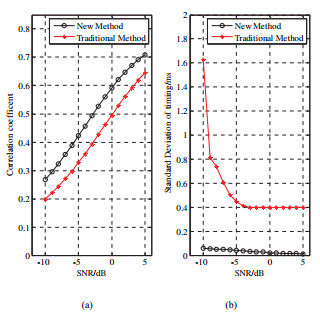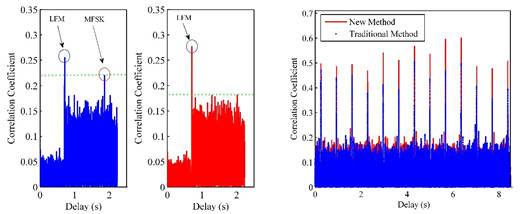Frame synchronization is of great significance in communication systems, especially for complex underwater communication channels. Frame synchronization is the process by which, while receiving a stream of framed data, incoming frame alignment signals are identified, permitting the data bits within the frame to be extracted for decoding or retransmission.
Since every communication system is formatted in a unique frame pattern, only with accurate frame synchronization can we recover information from the received signal. Lots of researches have focused on synchronization to improve the reliability of real-time underwater acoustic communication.
Recently, researchers GUO Zheng, YAN Shefeng and XU Lijun from the Institute of Acoustics of the Chinese Academy of Sciences consider the problem of false frame synchronization for underwater acoustic communication, and they propose a new frame synchronization approach based on Linear Frequency Modulation signal parameters estimation. This method they proposed, which is based on parameters estimation, has been simplified to save computational cost as to meet the needs of real time acoustic communication scenario.
Firstly, researchers analyze the frame synchronization interference caused by noise, Doppler and multipath. And then, they propose a new frame synchronization scheme based on parameter estimation, as is shown in Fig. 1.

Fig. 1 Frame synchronization process (Image by GUO Zheng et al.)
In this scheme, the synchronization process is started after the received signal is pre-processed. The signal is intercepted in a specific time window and processed by matched filter. Researchers take every signal whose correlation coefficient from matched filter is higher than the threshold as the possible synchronization signal. And the parameters are then estimated.
Traditional frame synchronization methods are based on a correlator and the reference signal used in the correlator has the same parameters as the transmitted signal. While in the signal propagating process, the received signal suffers severe distortion. Obviously, the traditional frame synchronization methods are not the optimal way for frame synchronization. Two parameters estimation techniques, including Fractional Fourier Transform (FRFT) estimation and Maximum Likelihood (ML) estimation, have been compared, and Maximum Likelihood Estimation Maximum Likelihood estimation is applied in the newly proposed method.
A simplification of the Maximum Likelihood estimation algorithm has been derived to save computational cost. Since the two parameters of the received Linear Frequency Modulation signal are correlated with Doppler factor, the Maximum Likelihood estimation algorithm, which is fulfilled by searching for the maxima in the frequency-frequency rate plane, can be implemented only by searching in the one-dimension Doppler domain. Thus this method is implemented at less computational cost.
By avoiding a complex design of synchronization signal waveform and prolonging the synchronization signal time, communication rate can remain unaffected. Moreover, by exploiting parameter estimation techniques, this method can locate the frames of the received signal effectively.
Simulation results, as shown in Fig. 2, prove that the proposed method has a larger correlation coefficient than the traditional one. Hence, the detection capability can be improved. Besides, when signal-to-noise ratio drops to -4 dB, timing precision of traditional method worsens rapidly, while the new method keeps a low timing deviation even in low signal-to-noise ratio.

(a) Correlation coefficient between the received signal and the reference signal (b) Timing deviation of these two methods
Fig. 2 Comparison of two synchronization methods (Image by GUO Zheng et al.)
To verify this synchronization method, researchers also have done some experiments in Qiandao Lake when transmitter and receiver are relatively static and moving. Results are shown in Fig.3.

(a) Experiment of static communication (b) Experiment of mobile communication
Fig.3 Experiment results (Image by GUO Zheng et al.)
Both static and mobile communication experimental results show that the correlation coefficient of the new scheme is higher than that of the traditional one. By exploiting this new method, the detection ability of the receiver is improved. Therefore, false triggering and missed synchronization can be avoided. Thus, a reliable frame synchronization method is obtained.
Reference:
GUO Zheng, YAN Shefeng, XU Lijun. A New Method for Frame Synchronization in Acoustic Communication. OCEANS 2016- Shanghai. DOI: 10.1109/OCEANSAP.2016.7485448
Contact:
GUO Zheng
Institute of Acoustics, Chinese Academy of Sciences, 100190 Beijing, China
Email: guozheng@mail.ioa.ac.cn


